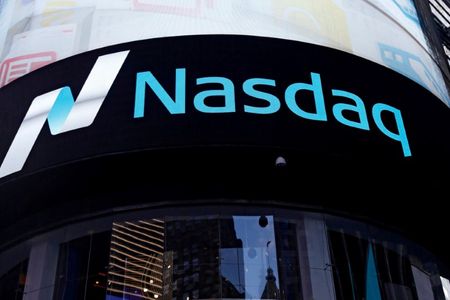By David French
(Reuters) – Conviction in the strength of the economic recovery pushed investors into U.S. technology stocks on Thursday, driving the Nasdaq higher, although a post-Fed hangover left a subdued S&P nursing a very minor loss.
The marginal decline was the S&P’s third negative finish in a row, while the Dow – with a more pronounced drop – posted its fourth straight lower close.
Many investors were still processing the Federal Reserve’s unexpectedly hawkish message on monetary policy from the previous day, which projected the first post-pandemic interest rate hikes in 2023.
Fed officials cited an improved economic outlook as the U.S. economy recovers quickly from the pandemic, with overall growth expected to hit 7% this year. While careful not to derail the recovery – with no end in sight for supportive policy measures such as bond-buying – the rate-rise signal highlighted concerns about inflation.
“I think there was a scenario that people had in mind, that the Fed was going to allow for a larger and longer inflation overshoot, and I think with the increase in the dot plot yesterday… people are rethinking that scenario,” said David Lefkowitz, head of equities for the Americas at UBS Global Wealth Management.
Technology shares, which generally perform better when interest rates are low, powered a rally on Wall Street last year as investors flocked to stocks seen as relatively safe during times of economic turmoil.
Investors returned to such positions on Thursday. Chipmaker Nvidia Corp jumped 4.8%, posting its fourth consecutive record close, after Jefferies raised its price target on the stock.
Meanwhile, shares of Apple Inc, Microsoft Corp, Amazon.com Inc and Facebook Inc shook off premarket declines to advance between 1.3% and 2.2% as investors bet that a steady economic rebound would boost demand for their products in the long run.
The Nasdaq ended 13 points short of its record finish on Monday, but it was still the index’s second-highest close ever.
The Dow Jones Industrial Average fell 210.22 points, or 0.62%, to 33,823.45, the S&P 500 lost 1.84 points, or 0.04%, to 4,221.86 and the Nasdaq Composite added 121.67 points, or 0.87%, to 14,161.35.
Graphic: U.S. tech stocks vulnerable to changes in interest rates – https://fingfx.thomsonreuters.com/gfx/mkt/dgkplnykepb/Pasted%20image%201623937801421.png
Interest rate-sensitive bank stocks slumped 4.3% as longer-dated U.S. Treasury yields dropped.
The strengthening dollar, another by-product of the previous day’s Fed news, pushed U.S. oil prices down from the multi-year high hit earlier in the week. The energy index, in turn, was off 3.5%, the biggest laggard among the 11 main S&P sectors.
Other economically sensitive stocks, including materials and industrials, fell 2.2% and 1.6% respectively as data showed jobless claims rising last week for the first time in more than a month. Still, layoffs appeared to be easing amid a reopening economy and a shortage of people willing to work.
Volume on U.S. exchanges was 11.77 billion shares, compared with the 10.67 billion average over the last 20 trading days.
The S&P 500 posted 23 new 52-week highs and 2 new lows; the Nasdaq Composite recorded 82 new highs and 37 new lows.
(Reporting by Shashank Nayar and Medha Singh in Bengaluru and David French in New York; Editing by Sriraj Kalluvila, Anil D’Silva, Maju Samuel and Dan Grebler)





